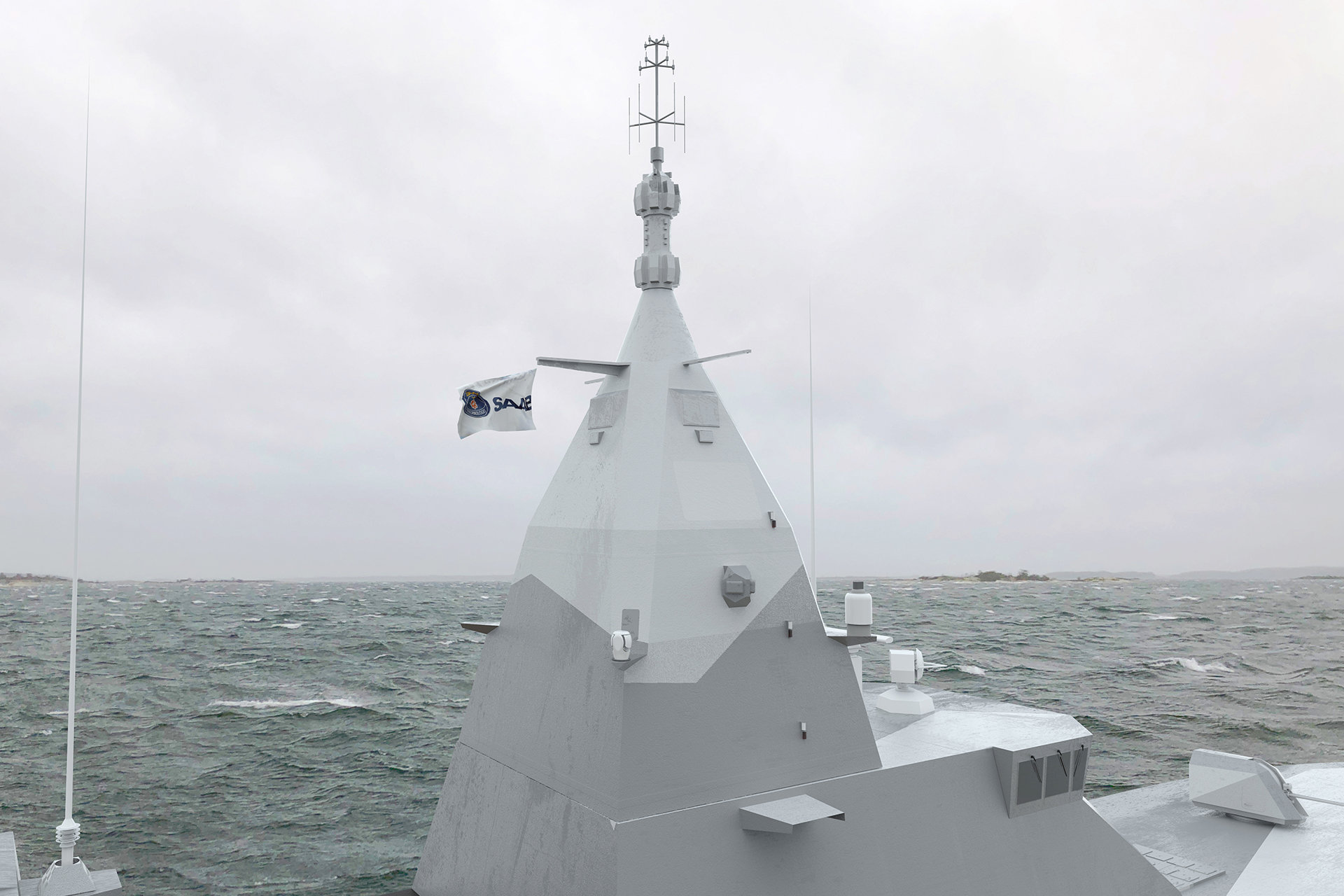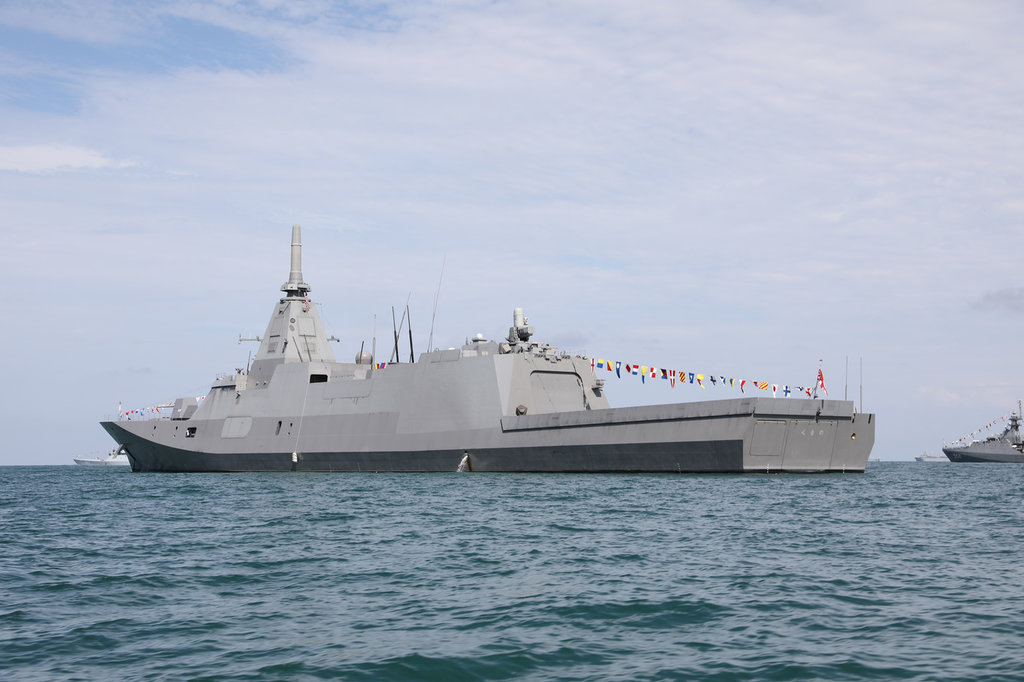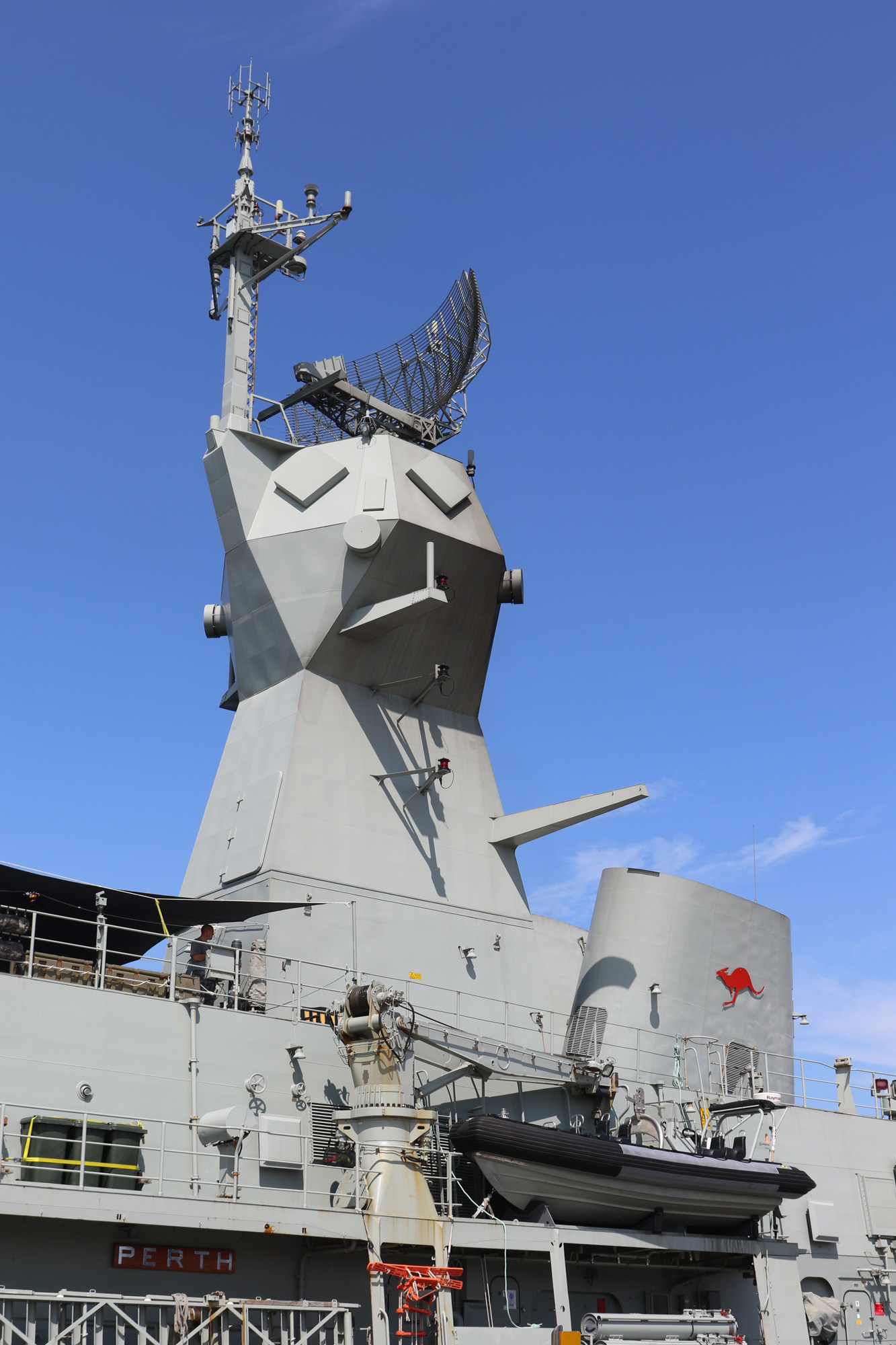Feature
Naval masts: the integration game
A visible but lesser understood element to the silhouette of a naval vessels is that of its mast, which contains all types of sensors required for modern operations. Gordon Arthur reports.

The Saab Lightweight Integrated Mast, pictured here, will be fitted on four Pohjanmaa-class multirole corvettes under construction for the Finnish Navy. Credit: Saab
One function of ship masts has stayed the same over the centuries, even if they are no longer required to hold sails aloft. The principle of a sailor ensconced in a crow’s nest to give him the farthest view possible remains valid, though of course this role has been taken over by advanced sensors. Yet the theory holds true that, the higher up the sensors are, the more effective is their range.
A ship’s mast is always a compromise. Sensors need to be high to maximise range and performance, yet naval architects do not want them too high as this affects a vessel’s stability and radar signature. Furthermore, multiple sensors and antennas must not interfere with each other, nor be unduly affected by all the ship’s steel. Mast design therefore represents the art of obtaining the best compromise.
Integrated masts
Over the years, naval architects have utilised various mast types, but the latest fashion is integrated masts. Apart from being aesthetically pleasing, they reduce clutter by eliminating dozens of separate antennas, and integrating the usual naval fare of radars, communications, navigation, identification friend or foe (IFF), fire control and electronic warfare systems.
Sensors in integrated masts offer higher operational availability since sensitive components are protected from harsh maritime environments, and maintenance can be carried out at sea. Other significant advantages are savings in below-deck space, reduced topside weight for better ship stability, and greater flexibility/upgradability.
Although a covered mast might weigh more than a lattice mast, for example, it produces a smaller radar cross-section, suffers less vibration and can carry heavier loads. Myriad protrusions and antennas are a delight for enemy radars, but an enclosed mast’s flat surfaces reduce reflective echoes.
Naturally, masts must be structurally integrated to endure static and dynamic loads as a ship moves through heavy seas. Naval designers must also consider the position, for it impacts stability, air resistance and topside electromagnetic environment, plus mast sensors can be affected by heat plumes from funnels. Yet sensors must be able to “see” through a mast’s panel structure. For example, the bottom half of the Advanced Enclosed Mast/Sensor (AEM/S) of the LPD USS San Antonio is sheathed in a balsa core, while the top half is a sandwiched foam core and structural laminates.

The Republic of Singapore Navy operates eight 1,200-tonne Independence-class Littoral Mission Vessels that boast Saab’s SLIM. Credit: Gordon Arthur
Integrated masts help deconflict electromagnetic and line-of-sight obstructions. Placed high inside a mast, layered sensors and antennas with clear fields of view and reduced electromagnetic friction operate more efficiently. Clustered omnidirectional and directional antennas simultaneously transmitting and receiving in different wavelength spectrums place demands, but the aim is to achieve minimal performance degradation of each sensor and antenna.
As an example, Thales Nederland created its Integrated Mast (I-Mast) family with four deck levels – top deck, upper and lower antenna decks, and equipment deck – while a shielded duct routes cables and cooling circuits through the centre of the airtight mast. I-Masts are fitted to Royal Netherlands Navy Holland-class OPVs, for instance.
Naval Group in France also offers integrated masts like the Panoramic Sensors and Intelligence Module (PSIM). Fitted to French Navy FDI frigates and Gowind 2500 corvettes, the PSIM can vary from 80 to 150 tonnes, and 25-45m in height. It can have anywhere from three to seven levels of operational and technical rooms, accommodating either fixed or rotating antenna.
A spokesperson from Naval Group explained: “The PSIM provides the ship with 360° operational coverage for sensors and communications. It is designed to meet the widest range of customer requirements in terms of number of sensors, consoles and electronic equipment. Because it is designed for a stand-alone operation ashore, equipment and functional chains can be tested early before installation on board the ship, more than a year before first sea going, to identify any technical difficulties, characterise them and resolve them before going at sea.”

This is JS Kumano, the second Mogami-class frigate of the Japan Maritime Self-Defense Force. Evident is the UNICORN mast that integrates eight different antenna types. Credit: Gordon Arthur
To gain true benefits from advance construction of the PSIM, Naval Group noted that “the PSIM has to be built early, and therefore physical and functional integration studies have to be carried out during the early phases of the programme. The equipment (radar, communications, etc) and Naval Group combat system software have therefore to be available as soon as possible in order to secure the ship’s overall schedule.”
Furthermore, parallel construction means integrated masts can be powered up and fully tested separately from a ship’s construction. Once the vessel is assembled, its mast can be simply attached as a monolithic plug-and-play unit, with only limited tests required thereafter to ensure successful integration. This construction independence produces shipbuilding cost and time savings. Further money is saved because sensors last longer and are easier to maintain in their protected environment.
Japan’s developments
One of the newest masts available today comes from Japan. The UNIted COmplex Radio aNtenna (UNICORN) integrated mast is used on Japanese 3,900-tonne Mogami-class frigates being built by Mitsubishi Heavy Industries. Visually akin to a horn, the antenna-filled UNICORN sits above a plinth containing the OPY-2 active electronically scanned array radar.
Japan’s Acquisition, Technology and Logistics Agency (ATLA) picturesquely explained: “It’s an unprecedented antenna with brand new stealth capabilities that are extremely advanced. Compared to a conventional antenna or mast, the radar cross-section is greatly reduced, like shrinking a kimono down to the size of a sensu folding fan.”
In descending height, eight antennas are carefully arranged to avoid interference inside the UNICORN’s fibre-reinforced plastic radome: radar-waveband omnidirectional detection antenna; communication-waveband direction search antenna; Wi-Fi-band antenna; Link 16 antenna; UHF-band transmit/receive antennas; IFF response antenna; and UHF/VHF-band transmit/receive antenna. In the UNICORN’s base is a tactical air navigation (TACAN) antenna.
Interestingly, ATLA moved the circular TACAN antenna to the very bottom, enabling the electronic support measures (ESM) antenna to go at the top, for detecting incoming missiles, for instance.
Compared to previous masts on Japanese warships, the UNICORN’s height has reduced from 9m to 8m. The radome is removed by crane when the ship is berthed – a process taking several hours – and plug-in connectors attach ship cabling to the UNICORN’s baseplate. A lightning protection strip installed on the radome’s surface protects against current surges.

Although the Type 052D destroyer is one of the most modern warships of China’s PLA Navy, the mast here on Yinchuan bears numerous protrusions crying out for radar detection. Credit: Gordon Arthur
Japan has offered to export the UNICORN to India, but the Indian Navy is exploring indigenous integrated masts for installation on future destroyers. India will execute this project in two phases, the first integrating ESM, communications intelligence, VHF/UHF and data link antennas in a single mast. Phase two will integrate a radome.
Swedish innovations
Suppliers can customise the size and configuration of integrated masts, but one offering suitable for smaller warships is the Saab Lightweight Integrated Mast (SLIM). The SLIM is used on Singaporean Littoral Mission Vessels and Swedish Navy Visby-class corvettes. The Finnish Navy will also employ it on Pohjanmaa-class corvettes. Additionally, they have also been retrofitted onto existing surface ships like the Stockholm-class and Gävle-class corvettes.
Magnus Dannemyr, Saab Lightweight Integrated Mast’s product manager, told Global Defence Technology that Saab Kockums has been designing composite masts for decades. “SLIM is a lightweight design with approximately 50% reduced weight or less when compared with a steel mast of the same design, while being non-corroding due to the material … The design also means it is a turnkey solution for simpler ship installation.”
Further discussing its merits, Dannemyr added: “SLIM is lightweight, which in turn gives reduced topweight for increased ship stability, a higher mast to facilitate longer sensor range, and weight margin for more sensors, weapons and future growth. We can tailor it for enhanced performance based on customer and sensor choices thanks to the flexibility of its modular and scalable nature.”
Dannemyr acknowledged that a composite mast might initially be more expensive than a steel mast, but “the material choice and design mean lower lifecycle costs and reduced maintenance than solutions made of steel”
Australia’s efforts
BAE Systems Australia has upgraded eight Anzac-class frigates for the Royal Australian Navy. A spokesperson said BAE Systems developed a specialist mast manufacturing capability at Henderson, Western Australia as part of this work. There, integrated mast modules are fabricated and outfitted prior to installation on the frigates.
The process includes blast and paint, insulation, piping, electrical cabling and equipment installation. “This minimises the amount of work that needs to be conducted post-consolidation of the mast module on the ship,” the spokesperson explained.
Anzac frigate masts use high-strength, marine-grade, aluminium alloys for mast module construction and the complex shape of the mast, with tight dimensional tolerance requirements, has been largely driven by the requirements of the phased-array radar technology integrated by CEA Technologies, the spokesperson detailed. After their most recent upgrade, the frigates carry CEAFAR2-L phased-array radars.

The aluminium enclosed masts of the Royal Australian Navy’s eight Anzac-class frigates were fabricated by BAE Systems Australia. Credit: Gordon Arthur
BAE Systems Australia is drawing on this experience to construct a proof-of-concept mast for the nine-frigate Hunter class, with work already under way. Aluminium, because it is lightweight, frees up total gross weight that can be used elsewhere on the ship, thus contributing to future-proofing. “By removing weight from the structure (without compromising strength or performance), the vessel has increased margins to add weight into warfighting capability,” the spokesperson said. However, balance was described as key.
“By removing weight from the top of the ship, the vessel’s balance point moves lower, which makes the vessel more stable,” the spokesperson continued: “Construction and outfitting of the mast can be undertaken in workshops, independent of other work on the vessel and independent of the vessel being available. The workshop environment is readily accessible for trade staff, rather than having to conduct work in the ship environment, which provides a safer pathway to execute such large work scopes.”
Integrated masts present their own challenges, though. “Interface control between the mast and the ship are essential,” noted BAE Systems Australia. “The mechanical interface to the ship requires very tight tolerances and, when working with aluminium, this is a challenge. The electrical interfaces need to be clearly thought through when determining which cable runs should come from the mast to the ship, and vice versa, to maximise efficiencies.
"The support system interfaces for dry air, chilled water and HVAC also need careful consideration in the planning and design phase to ensure interconnectivity has been considered. Forward planning for material and equipment availability to maximise the level of outfitting in the workshop environment can always be a challenge when dealing with long-lead-time equipment.”
Far from being an afterthought, or a simple framework upon which the real capabilities are mounted, naval masts and their ongoing evolution towards integration solutions is central at the very outset of design. The successful incorporation of sensors into a viable structure appears to be a key element for current and future naval warships, offering significant advantages over those services unable, or unwilling, to adapt to the pace of change.